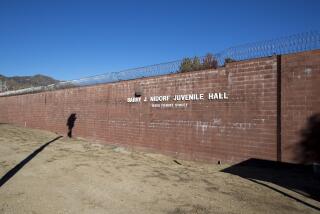Juveniles Can’t Be Saved in Adult Prison
- Share via
Earlier this year, as part of his open season on gangs and juvenile offenders, Gov. Pete Wilson proposed allowing 13-year-olds who are charged with murder to be tried as adults. But while legislators turned that proposal down, Assembly Speaker Cruz Bustamante came back with the suggestion that he could accept offenders as young as 14 being prosecuted and sentenced to adult facilities.
In Washington meanwhile, the Senate Judiciary Committee began last week to debate the merits of the Violent and Repeat Juvenile Offender Act of 1997. A study by the Justice Policy Institute in Washington contends that if the bill is enacted, it would “place thousands of teenagers at risk for suicide, rape and assault by adult prisoners.” The study predicted that young people incarcerated with adults were eight times more likely to commit suicide, five times more likely to report being raped or sexually assaulted and twice as likely to report being beaten by prison staff.
The authors of the study, Vincent Schiraldi and Jason Ziedenberg, contend that before any such measures are passed, more research needs to be conducted on the long-term social and physical impact on youthful offenders. They believe that the Senate bill would be extremely detrimental to young offenders, because it would force states to transfer large numbers of juveniles to adult prisons or face cutoff of federal funding, permit young offenders to be held in adult jails before they are convicted, and allow publication of their names in the press; in short, it would punish these young offenders at every step of the criminal justice system.
Clearly the publication of young offenders names’ could be a major obstacle for their reentry to their communities and on their ability to obtain future employment. Further, sending young offenders to adult facilities would place them in a predatory environment where they are open to all kinds of inmate assaults and to becoming the “prototype” prison rape victims. And in adult facilities, juveniles would have opportunities to learn more destructive criminal behavior, which would only result in increased violence and crime when they were released.
I have taught at California Youth Authority institutions where I’ve met young people deserving of a second chance. I remember Joyce, a 17-year-old from Inglewood who, under the influence of “angel dust,” had burned and crippled an infant. Joyce used her three years of incarceration to turn her life around by actively participating in group therapy sessions, finishing high school and diligently applying herself in my college freshman literature class.
And there was Hector from Camarillo, convicted at 15 of stabbing his abusive stepfather to death. He wrote in a creative writing class, “I understand I can’t bring him back, but my plan is to show them when I get out of here that I can live my life in a good way.”
We have 19,000 youth incarcerated in California Youth Authority schools, ranches or camps. These facilities still have a mission to rehabilitate their charges, in the hope that they will become productive individuals. If Joyce and Hector had been jailed in an adult facility, I doubt that we would ever have been able to reclaim them.
Ninety-four percent of young offenders stop all of their criminal behavior after three encounters with the juvenile justice system. There is no need to establish a dangerous system geared for the 6% of hardened youth offenders.
More to Read
Sign up for Essential California
The most important California stories and recommendations in your inbox every morning.
You may occasionally receive promotional content from the Los Angeles Times.










